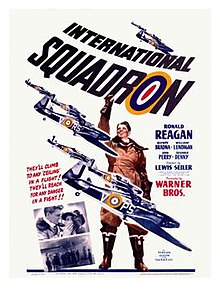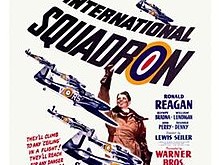International Squadron ** (1941, Ronald Reagan, Olympe Bradna, James Stephenson) – Classic Movie Review 10,671
Director Lewis Seiler and Lothar Mendes’s 1941 American war film International Squadron finds Warner Bros recycling another old script and Ronald Reagan taking on James Cagney’s old role from the 1936 Ceiling Zero (based on Frank ‘Spig’ Wead’s play) as American daredevil pilot Jimmy Grant, a ne’er-do-well who joins the Royal Air Force’s International Squadron, made up of Americans, and is turned by the RAF into a top fighter in World War Two.
International Squadron features routine heroics, with Reagan nowhere near to Cagney in charisma rating and a script that doesn’t help him. Still, the film is a high-flier in the air, with a historically fascinating background and lots of interesting detail of the time, though of course the special effects of the day look pretty dodgy now.
Olympe Bradna also stars as Jeanette, the young French woman assigned as Reagan’s driver, and it features Hollywood pilot Paul Mantz, who acted as aerial coordinator and flew in the film. Also in the cast are James Stephenson in his final film, Julie Bishop, Cliff Edwards, Reginald Denny, William Lundigan, Joan Perry, Tod Andrews, John Ridgley, Selmer Jackson, Addison Richards, Holmes Herbert, Eddy Conrad, Crauford Kent, and Frank Faylen.
The film’s premise is based on a major news item of the day, the real-life Eagle Squadrons, American pilots who volunteered to fly for the RAF in World War Two. Producer Walter Wanger was quick to copyright the name ‘Eagle Squadron’ for his film of that name released in early 1942. Producer Darryl F Zanuck of 20th Century Fox wrote angry letters to Hal Wallis of Warner Bros and threatened legal action, accusing them of stealing his idea of A Yank in the RAF and making a B-movie to beat his film to cinemas. Warner Bros went ahead but changed their film’s title from Eagle Squadron to International Squadron and released it two months before A Yank in the RAF.
Warner Bros hired Byron Kennerly, a former member of an Eagle Squadron as the film’s technical advisor.
Film of dog-fighting between Spitfires and Messerschmitts and Heinkels and a London air raid were shot by Warner Bros’ UK Teddington studios technicians and shipped to the US to be cut into the film.
The film’s modest budget necessitated the use of the Alhambra, California Municipal Airport standing in for an RAF base, and civil aircraft standing in for the latest RAF fighters.
It was a TV regular until the Nineties, when legal complications involving the original version, Ceiling Zero (1936), prevented it being shown on cable TV, VHS or DVD.
© Derek Winnert 2020 Classic Movie Review 10,671
Check out more reviews on http://derekwinnert.com



